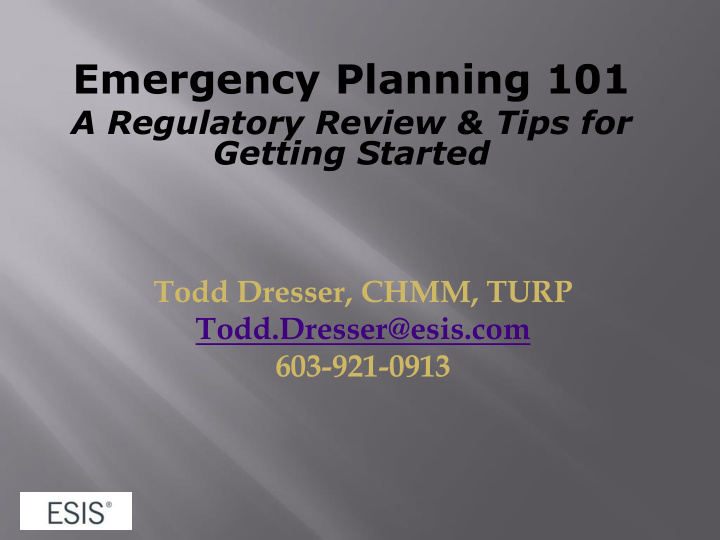



Emergency Planning 101 A Regulatory Review & Tips for Getting Started Todd Dresser, CHMM, TURP Todd.Dresser@esis.com 603-921-0913
EPCRA & SARA Title III RCRA Oil Pollution Prevention Act (SPCC) CFATS – Chemical Facility Anti-Terrorism Standard CAA – Risk Management Program OSHA – Process Safety Management Standard* MA Hazardous Materials Processing* Regulation
Requires facilities storing materials in excess of Threshold Planning Quantities (TPQs) – typically 10,000 lbs to file annual Tier II with local emergency responders. Lower TPQs (e.g. 100 to 500 lbs) for extremely hazardous substances (EHSs – chlorine, AA, HF) EHS facilities must work with LEPC & FD to develop emergency response plan. Tier II filers are expected to support and participate in LEPC/REPC. Provides broad authority to LEPC/FD to request information to support local planning effort.
LQGs are required to develop a Contingency Plan and share it with local emergency responders. LQGs are now required to work with local responders to develop a site pre-plan. SQGs are encouraged to develop a Contingency Plan and share it with emergency responders.
Facilities that store more than 1320 gallons of petroleum on site are required to develop a Spill Control & Countermeasures Plan (SPCC Plan). Regulated sites must initiate control measures to prevent the release of petroleum. Site must identify and train response staff. Site must identify off site resources to provide spill response when needed. Site is required to conduct monthly inspections.
Facilities storing specific materials above planning threshold are required to report and screen their facility for risk using Homeland Security protocol. Facilities deemed a risk may have to complete more in depth screening or may be inspected by Homeland Security. Sample materials of concern: anhydrous ammonia, chlorine, propane
Facilities that store respiratory toxins (e.g. chlorine or anhydrous ammonia) above planning thresholds must prepare RMP plan. RMP plan will include a comprehensive review of the facility, identify control or mitigation measures, requires the preparation of a worst case and realistic release scenario. These facilities can pose major risks that can impact square miles.
Facilities that store or use specific flammable or toxic materials on site usually in excess of 10,000 lbs are required to develop a PSM plan. The standard requires the facility to conduct a comprehensive hazard analysis and to initiate control measures to mitigate the risk posed by site operations. These facilities can pose a major hazard. These sites should actively coordinate with local responders to develop a training and response plan.
Most businesses using hazardous materials are now required to provide process information to local responders & obtain a permit from the FD. This standard applies OSHA PSM type requirements on facilities that have tanks/containers with a volume of 300 gallons. Grants broad authority to FD to seek information for planning purposes. Requires facilities to work with FD to develop an emergency response plan.
Create review checklist for use during site plan or permit review process. Ask applicant if any of these requirements apply to their operation. Require a written response. Hint: Also ask for a copy of their chemical inventory to compare. Require applicants to provide copy of their response plans and to work with responders to develop pre-plan. Remember state & federal agencies will help if sites are unresponsive.
Highway Garage Drinking Water Plants Wastewater Plants Ice Rinks Municipal Pools Motor pool/fleet operations Grounds/field maintenance Airports Port Authorities
Identify & address historic problem areas. Identify & plan for likely scenarios. Collect & organize the info you would need if these events occur.
Process or system Potential for run away upset reactions Structural failure Weather induced problems Transportation release Issues causing greater Problems caused by concern during a fire loss of power or water External impacts
Focus on what you can manage. Work through scenarios for 3 most likely problems. Inspect, maintain, repair or upgrade your equipment. Develop procedures and train staff to support effort. Review, practice and update procedures. Drills help alleviate the mental fog that can occur in a crisis.
Invite the fire dept. to tour your facility. Share your Contingency Plan. Make the most of your Knox box. Create a Pre-plan Review high hazard/critical processes or storage areas. Label and photograph these areas. Do you need specialized medical support Cyanides, Hydrofluoric acid or others? Consider a drill.
Identify critical do’s & don'ts's Establish incident command and notification procedures. Identify safety controls to be maintained. Plan for 3 likely potential problems. Identify potential external impacts - develop notification or response procedures for these receptors. Train staff Review plan with emergency responders.
Insert photos of the process controls and storage containers into the plan to assist responders.
Questions?? Todd Dresser, CHMM, TURP Todd.Dresser@ esis.com 603-921-0913 https://www.linkedin.com/todddresser
Recommend
More recommend